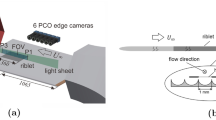Abstract
An experiment was carried out in a low-speed wind tunnel to study the turbulence structure of the boundary layer over a two-dimensional square cavity on a flat plate. The main purpose of this investigation is to examine the way a square cavity modifies the near-wall structure of the turbulent boundary layer leading to a possible drag reduction overd-type roughness. The experimental results on pressure coefficient and friction coefficient indicated a small reduction in total drag in this configuration. This seems to be due to the stable vortex flow observed within the cavity which absorbs and reorganizes the incoming turbulence in the cavity, thereby modifying the near-wall turbulence structure of the boundary layer. The resultant turbulence structure was very similar to that over drag-reducing riblets surface.
Similar content being viewed by others
References
Choi, K.-S., Near-wall structure of a turbulent boundary layer with riblets.J. Fluid Mech. 208 (1989) 417–458.
Choi, K.-S., Cost-effective production of micro-grooves for drag reduction on the surface of aircraftin situ.SPIE — The International Society for Optical Engineering, Proceedings Volume 1573 (1992) 136–144.
Tani, I., Munakata, H., Matsumoto, A. and Abe, K., Turbulence management by groove roughness. In: Liepman, H.W. and Narasimha, R. (eds),Turbulence Management and Relaminarisation. Berlin: Springer-Verlag (1987) pp. 161–172.
Tani, I., Some equilibrium turbulent boundary layers.Fluid Dynamics Research 1 (1986) 49–58.
Rotta, J.C., Turbulent boundary layers in incompressible flow.Prog. Aeron. Sci. 2 (1962) 1–219.
Townes, H.W. and Sabersky, R.H., Experiments on the flow over a rough surface.Int. J. Heat Mass Transfer 9 (1966) 729–738.
Maul, D.J. and East, L.F., Three-dimensional flow in cavities.J. Fluid Mech. 16 (1963) 620–632.
Haugen, R.L. and Dhanak, A.M., Momentum transfer in turbulent separated flow past a rectangular cavity.ASME J. Appl. Mech. 33 (1966) 641–646.
Choi, K.-S., Fujisawa, N. and Savill, A.M., Studies of drag reducingd-type roughness — including flow visualisation, image enhancement and quantitative measurements. In Reznicek, R. (ed.),Flow Visualisation V. New York: Hemisphere (1989).
Tani, I., Iuchi, M. and Komoda, H., Experimental investigation of flow separation associated with a step or a groove.Aero. Res. Inst., Univ. Tokyo 363 (1961).
Roshko, A., Some measurements of flow in a rectangular cutout.NACATN 3488 (1955).
Patel, V.C., Calibration of the Preston tube and limitations on its use in pressure gradients.J. Fluid Mech. 23 (1965) 185–208.
Coles, D., The law of the wake in the turbulent boundary layer.J. Fluid Mech. 1 (1956) 191–226.
Fanourakis, P., A study of rough surfaces with drag reducing properties in turbulent flow.Engr. Dept. Rept., Cambridge Univ. October (1989).
Abe, K., Matsumoto, A., Munakata, H. and Tani, I., Drag reduction by sand grain roughness. In: Gyr, A. (ed.),Structure of Turbulence and Drag Reduction. Berlin: Springer-Verlag (1990) pp. 341–348.
Klebanoff, P.S., Characteristics in a boundary layer with zero pressure gradient.NACA TN 3178 (1954).
Tani, I., private communication (1988).
Perry, A.E., Schofield, H.W. and Joubert, P.N., Rough wall turbulent boundary layers.J. Fluid Mech. 37 (1969) 383–413.
Townsend, A.A.,The Structure of Turbulent Shear Flow, 2nd edn. Cambridge: Cambridge University Press (1976) pp. 139–143.
Author information
Authors and Affiliations
Rights and permissions
About this article
Cite this article
Choi, K.S., Fujisawa, N. Possibility of drag reduction usingd-type roughness. Appl. Sci. Res. 50, 315–324 (1993). https://doi.org/10.1007/BF00850564
Issue Date:
DOI: https://doi.org/10.1007/BF00850564




